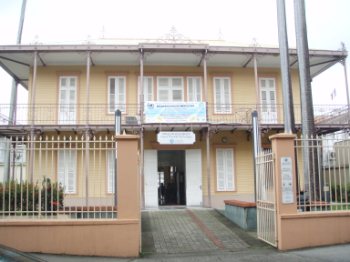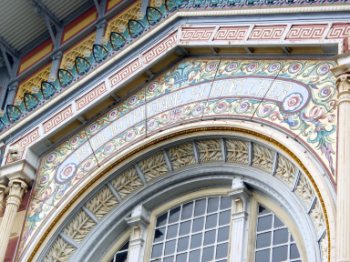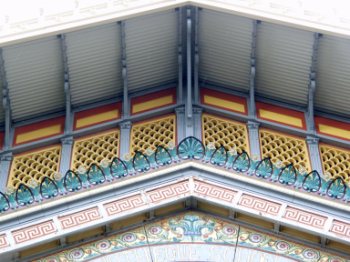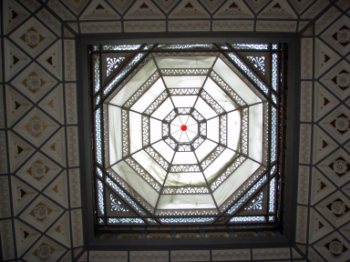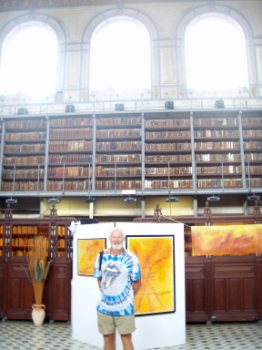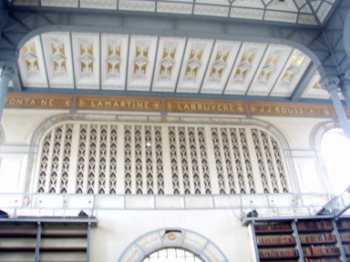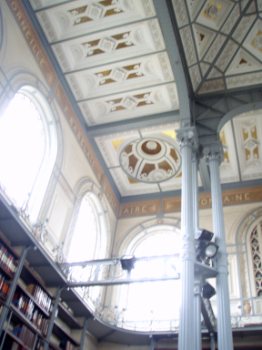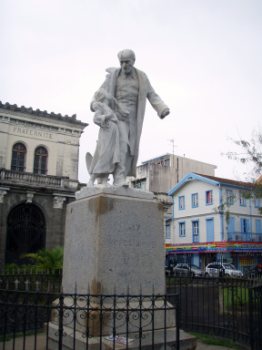|
Schoelcher's Library and
Bougenot's Mansion
Bougenot's
Mansion, information and building. Our
first look at the library from the side.
Opened in March 2004 Bougenot's
Mansion is an annexe to Schoelcher's Library.
The Press and Documentation
Department. On the ground floor there is a study room with access to on-line
regional, national and international periodicals of the current year.
The Multimedia - Cyberspace
Department. Offers initiation and awareness for beginners in multimedia and the
Internet. 400 CD-ROMS are available.
The Department for the Visually
Impaired. Offers writings in Braille, 5,000 "speaking book" cassettes and
hundreds of CD's.
Emile Bougenot
achieved a degree in mechanics at Chalon-sur-Marne School of Arts and Techniques
in 1859 and was a shareholder in many sugar cane factories in Martinique. He was
administrator and director of the Cail and Co in charge of setting up the steam
factory of Lareinty in 1860. The technical revolution at that time made him the
main man for the creation and administration of a web of centrally quoted
factories and for the promotion of an era of great industrial revolution for
Martinique mainly for putting forward the use of steam as a technique for the
manufacture of sugar. It would be a period of prosperity for the industrialists
of Martinique and for Emile Bougenot the accumulation of properties and
wealth.
The mansion, originally bought by
Eugene Eustache in 1872 is six hundred square metres of bourgeois pavilion, made
on a concrete base and iron framework. Wood was also used for the construction:
its verandah is sheltered by an iron framework balcony with wooden floors around
all four walls. The high windows with little panes, the thin interior columns
remind us of the island colonial style and past. Its gardens with its straight
lines holds specimen tropical flowers and many majestic royal palm
trees.
By marrying the only daughter of
Eugene Eustache, owner of Galion Sugar Factory, Emile Bougenot became one of the
most powerful industrialists of Martinique. He inherited the mansion on the
death of his wife. For many years the mansion was Emile's residence, he also
used it as an agency and central office for all his business affairs. Under the
Vichy Government, the property was taken as a requisition to open an Information
Service. After the war ended and until 1949, the broadcasting services occupied
the place and it was only in 1961 it was given to the General Council of
Martinique which set up its Social and Sanitary Direction Offices.
This
architectural masterpiece in the heart of Fort de France, originally
built in the Tuileries Gardens in Paris in 1887 for the Parisian public.
Dismantled, it was shipped piece by piece and reconstructed here.
The architectural challenge: The
construction of the library is a challenge taken up by its designer and
architect Pierre-Henry Picq. However he must, above all, consider the weather
conditions of the Caribbean, a region located in marshy areas with a high risk
of earthquakes. He therefore preferred iron for the decorative aspects, cement
and glass for the structure itself, whose stiffness, elasticity and flexibility
contributes to resisting tremors. Timber is only used for the doors and window
frames, limiting fire damage and infestation by creepy-crawlies. A specific
system of thermal insulation aerates the reading room.
Picq's approach was quite original in
that it largely borrowed from a classical style, inspired by the tradition of
antique, Doric, Ionic and Corinthian architecture, offering a gracious blend of
Florentine and Baroque esthetic elements.
Picq added a touch of the Near East,
especially in the Moorish polychrome walls and Byzantine mosaics. The floral
decor and the abundance of shapes reflecting nature, recall the Art Noveau in
vogue during this period. These elements add to make this building "Exotic"
architecture where, through the diversity of sources, emerges an undeniably
harmonious ensemble with simple, functional, well lit volumes.
Pierre-Henry Picq
1833-1911. Trained as an ornamental sculpture. He participated in the School of
Fine Arts Contest exhibition at the World Fair.
1883 he signs the blue-prints of the
library - museum in Fort de France where he has a few close ties: his Martinican
wife Lucie Briere de I'Isle. Furthermore his father-in-law, related to the
Perrinon family, is well connected in republican and abolitionist circles in
Martinique and in Paris. Also, it seems he was on friendly terms with Victor
Schoelcher himself.
In 1891 he proposed the blue-prints
for the Fort de France Cathedral.
From 1893-1897, he rebuilt the church
in Francois, he leaves a trail in Fort de France where he built the dome of the
"Printemps" building with its characteristic metallic architecture.
Another city,
another map, skipper finding out info for me. The
amazing detail and colour of this striking building.
I trotted up to the lady on the desk
and asked if I would be allowed to take some photographs. I got her permission
and happily started snapping away at the equally amazing interior. Bear pointed
out all the signs saying photography forbidden, Oh well, lucky me. The stunning
dome in the ceiling. Some of the
collection of books and the lovely tiled
floor.
The metal spiral
staircase, the intricate patterns on the walls and ceiling.
We sailed past the commune of Case-Navire which
took the name of Schoelcher in 1888, in the man's honour.
The left-hand-less statue of
Schoelcher (the man has his own blog) stands outside the Town Hall in
Fort de France.
On the 22nd of May 1848, Victor Schoelcher abolished
slavery from Martinique, liberating over 70,000
slaves.
The origin of the Schoelcher Library dates back to
1883. Ten years before his death, the famous abolitionist and great
philanthropist donates 9,534 books as well as musical scores which are shipped
in 1884 and installed in a building on Rue Victor Hugo. On August the 5th 1884
the Official Bulletin of the Colonies renders the assignment of the first
Library Curator, Mr. Cochinat, public. Until that date, he was former Magistrate
at Orleans and former secretary of Alexander Dumas, Snr. Following Schoelcher's
donation, Cochinat brings the libraries collection to 11,000
volumes.
Initial Mission of the Library: To safeguard the
collection. Lend books to the public, excepting precious or reference books,
albums, encyclopedia etc.
22nd of June 1890: A violent fire destroys the major
part of the collection. The rescued books is in part transported to Fort Saint
Louis, to the Artillery Headquarters; a few years later, approximately 1,599
bound volumes permanently occupy their spots in the present building,
specifically designed for conserving them.
In 1893 the General Council (locally elected
assembly) and the Government added their donation to the volumes rescued from
the fire; finally individual donations were
offered.
A credit granted by the General Council yearly
contributes to reconstituting the collection.
Around August 1919, after having oscillating between
small pleasures and great misfortune the Schoelcher Library settles into a
period of prosperity with the assignment of the new library Curator Mr. Simeon
Petit. Very early on, he appeals to the public authorities, which results in
generous donations from local authors, Martinicans living in France, readers,
Fort de France Town Councillors, the Mayor of the city himself, Victor Severe,
the Teachers' League and the International Colonial Association, considerably
broaden the initial fabric woven by Schoelcher.
Periodicals will receive
special attention and, simultaneously specific care to binding the collection's
books.
Between 1925 and 1935 the library management strives
toward having it become a veritable working library at the disposal of the
general public.
ALL IN ALL AN AMAZING BUILDING,
WE ARE DELIGHTED IT IS FREE FOR ALL TO USE AND ME TO PHOTOGRAPH. Cheeky monkey, trust you. "I did
ask".
| 

